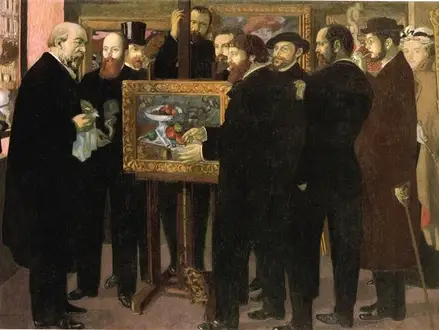Title of Artwork: “Homage to Cezanne”

Artwork by Maurice Denis
Year Created 1900
Summary of Homage to Cezanne
An oil on canvas work by the French artist Maurice Denis entitled “Hommage a Cézanne” (French: Hommage à Cézanne) dates back to 1900. It represents a number of important members of Les Nabis, a once-secretive brotherhood (Hebr. the Prophets). By 1900, the group had disbanded as its members grew older, and this artwork offers a look back.
All About Homage to Cezanne
At the centre of this painting is an easel with an 1879–80 still life depicting a fruit bowl filled with apples by Paul Cézanne, which Maurice Denis has assembled a group of people to celebrate. The setting is Ambroise Vollard’s gallery in Rue Laffitte.
Paul Gauguin, who left France permanently for the South Seas in 1895, is evoked by the Cézanne work, even though he is not depicted. Cézanne was regarded as “an exquisite pearl, the apple of my eye” by Gauguin. In the background, you’ll notice paintings by Gauguin and Renoir.
Many of the prominent members of the Nabis secret society, which Gauguin helped to organise, are depicted here. Odilon Redon, Paul Sérusier (Nabi instigator), Paul Ranson, Ker-Xavier Roussel, Pierre Bonnard with a pipe, Ambroise Vollard behind the easel, Maurice Denis, Paul Ranson, Ker-Xavier Roussel, Pierre Bonnard, and Marthe Denis, Maurice’s wife, are all pictured.
Redon, the group’s oldest and most revered member, stands apart from the rest. Sérusier appears to be explaining to Redon why the Nabis regard Cézanne so highly.
It was Cézanne, rather than fellow Symbolist Gustave Moreau, with whom Redon was most intimately linked throughout time. In Denis’ opinion, “the lesson of Redon is his powerlessness to paint anything that does not depict a state of soul, that does not communicate some depth in feeling or that doesn’t translate an interior vision.”
The painting’s nearly life-size dimensions (180 cm high by 240 cm wide) add to its overall impact. Foreground and background are defined by powerful verticals in their erect positions, which are contrasted by a framed still life’s brilliant red rectangle.
There is a lot of activity going on right now. The easel that Vollard is holding is protruding above the painting’s top edge, and the characters fill the canvas to the brim, leaving little room for anything else. As a result, Mrs. Denis is forced to observe Bonnard from behind her. The heads of the group offer a horizontal rhythm to the painting, contrasting the strong verticals. The Nabis’ avant-garde reputation is belied by their conventional black clothes.
Described by Belinda Thomson as Denis “moving away from the more spectacular, subjective Symbolism of Gauguin and van Gogh towards what he considered as the reassertion of classical virtues in Cézanne.” When Denis and Gide visited Rome in 1898, he discovered a revived passion in classicism.
Classicism was at the heart of French cultural tradition, according to articles he wrote such as “Cézanne” in 1907 and “De Gauguin et de Van Gogh au classicisme” in 1909. He impacted a new generation of French artists as a result of his actions.
Information Citations
En.wikipedia.org, https://en.wikipedia.org/.
























